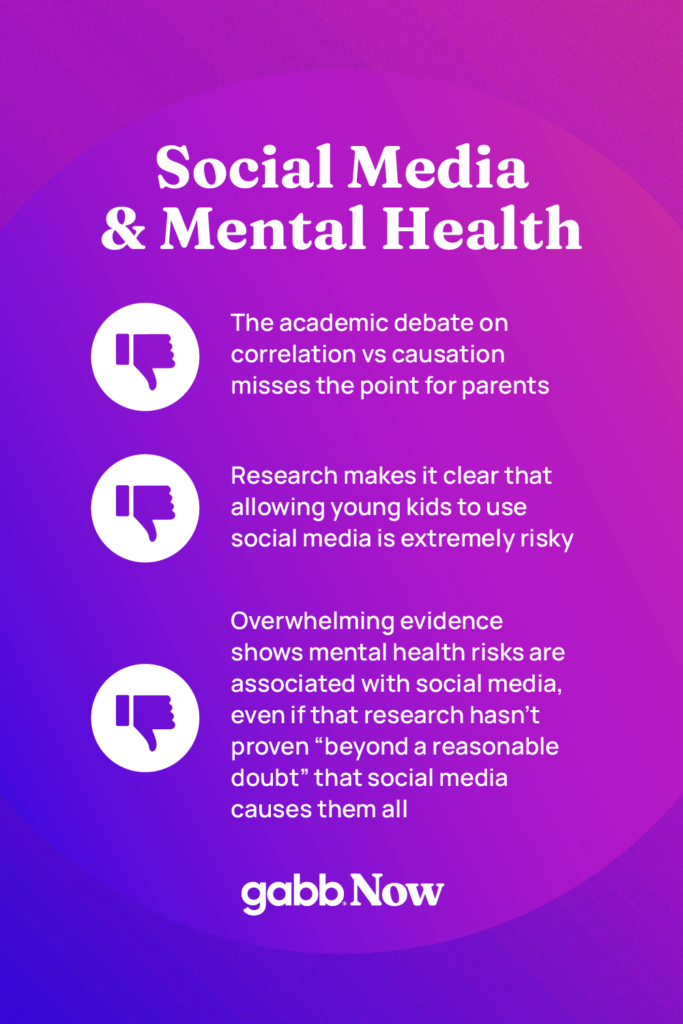For something that’s been around for twenty years, social media has been in the news a lot lately.
Plenty of people have worried about mental health and social media for a while. But it is only in the last several years that strong evidence has emerged to suggest that this radical shift in the way we connect to each other brought some severe unintended consequences with it.
Even more recently — in the last 1-2 years — we’ve seen a small but significant change in the conversation about social media and mental health statistics, especially in regards to the impact social media is having on adolescents.
Anxiety and depression, suicidal ideation, poor body image, and other mental health concerns are complicated. Proving that a single factor causes a mental health issue is extremely difficult to do. So using the word “causation” is a bold claim for a researcher and carries a lot of reputational risk — but many have started to do exactly that.
For parents who don’t get paid to read long think-pieces and interviews, let alone analyze countless data sets, it’s tough to make any amount of time to get to the bottom of it all.
I don’t have a PhD and I’m not a clinical psychologist, but I am a parent and, as the managing editor of Gabb Now, I do have a luxury most parents don’t: time to dive deep on this stuff.
So for those who might feel overwhelmed in forming an educated opinion on how social media influences mental and emotional health, here’s everything you need to know.
Effects of Social Media on Mental Health
The impact of social media on mental health is getting a lot of attention right now. From advisories issued by the U.S. Surgeon General to bestselling books on the topic, a lot of experts are connecting the dots between the hours spent on social media platforms and dramatic rises in anxiety, depression, and other mental health concerns.
Just because the narrative has recently shifted toward the argument that social media is causing mental health issues doesn’t mean there’s consensus. There are still plenty of skeptics of the causation claim. Also not surprisingly, social media executives are doing their part to fuel that skepticism.
Take a recent quote from Meta CEO, Mark Zuckerberg, as a perfect example: “the majority of the high-quality research out there suggests that there’s no causal connection at a broad scale between these things.”
So the debate is on, and that’s a good thing. That friction typically leads to the truth.
Before we get to all the mental health and social media statistics, it’s worth talking about the stakes of all of this data. Why should the correlation vs. causation debate matter to us, as parents, in the trenches with our kids? A few reasons.
- If consensus arrives on causation, these social media apps will be held responsible. This could mean big changes to the social media platforms themselves, which would influence whether or not you feel your child is okay using them. This could also mean you don’t have to (or get to) make a decision on whether your kid uses social media before a certain age. Think of tobacco laws as an example.
- Even without consensus, if you personally feel convinced of the negative impact of social media, then you’re likely going to take a much firmer stance on keeping your own kid off these platforms for as long as possible.
- If it becomes clear that social media isn’t causing poor mental health then we need to look elsewhere to figure out what is. Because we definitely have a teen mental health problem to deal with.
On to the data.
Social Media and Mental Health Statistics
Jean Twenge was one of the first experts to bring the topic into the mainstream and suggest a causal link, back in 2017. Twenge is a psychology professor who has studied generational differences for over 30 years.
“I had grown accustomed to line graphs of trends that looked like modest hills and valleys,” Twenge said, “Around 2012, I noticed abrupt shifts in teen behaviors and emotional states. The gentle slopes of the line graphs became steep mountains and sheer cliffs…I had never seen anything like it.”
What’s significant about 2012? In Twenge’s words, “it was exactly the moment when the proportion of Americans who owned a smartphone surpassed 50 percent.”
Twenge continues to be a leader in the conversation and, by 2024, has been joined by a number of experts, not the least of which is Jonathan Haidt.
Haidt is a social psychologist, author of The Anxious Generation, and co-author of a Substack called After Babel. For parents wanting to stay in-the-know, he’s a good source to keep an eye on. He addresses the topic head-on and always does a good job of acknowledging the other side of the debate, and including links to those arguments. I used him as a starting point to round up a handful of the key arguments below.
Arguments for Causation
- The Case for Causality Part 1 | After Babel
- The Case for Causality Part 2 | After Babel
- The Case for Causality Part 3 | After Babel
- The Terrible Costs of a Phone-Based Childhood | The Atlantic
Arguments against Causation
- The Panic Over Smartphones Doesn’t Help Teens | The Atlantic
- Don’t panic about social media harming your child’s mental health – the evidence is weak. | inews.co.uk
- Why I’m Skeptical About the Link Between Social Media and Mental Health. | Psychology Today
- The Statistically Flawed Evidence That Social Media Is Causing the Teen Mental Health Crisis | Reason.com
- The association between adolescent well-being and digital technology use | Nature
All the Studies in One Place
- Social Media and Mental Health: A Collaborative Review | Jonathan Haidt, Jean Twenge, and Zach Rausch
If you have the time and interest to research more deeply, the list above will give you a good knowledge base. If not, that’s okay.
For parents, I think all of it really boils down to a couple of questions:
What standard of proof do you need?
What do you risk by keeping your kid off social media?
What Standard of Proof Do You Need for Your Kid?
We all need reasons to make the decisions we do, but the standard we use shifts depending on the implications of the situation. For example, it doesn’t take much for my boys to convince me to run to the local bakery to get doughnuts (they succeed almost once a week). It will take a whole lot more for them to convince me to get a dog (they’ve tried and, so far, failed).
There are actually terms for the differing levels of proof people need before making a decision: 1) beyond a reasonable doubt, and 2) preponderance of evidence. The terms don’t really matter. What matters is that the concepts apply to parents who are wondering what to do about social media.
The first level — “beyond a reasonable doubt” — is the highest standard of proof and essentially means that the evidence is so strong that every rational person who looks at it is going to make the same conclusion.

The second level — “preponderance of evidence” — is a lower standard but is used more commonly in day-to-day decision-making. It basically equates to evidence being just strong enough to suggest that one conclusion is probably better than the other.
No expert I’m aware of is arguing that social media has no impact on us. The two sides of the argument are basically differing on what standard of proof the data shows about the net effect of social media: is it irrefutable that social media causes more harm than good to kids, or is there some level of doubt?
If you’re like me, I’m guessing that, “social media probably isn’t good for your kid’s mental health,” is enough for you to keep your own child away from it. This was essentially the point made by U.S. Surgeon General Vivek Murthy when he recently argued that social media should carry warning labels.
But, that being said, it’s still worth considering the positives offered by social media.
What Do You Risk? Pros and Cons of Social Media on Mental Health
One of the most common arguments from skeptics of the causation claim is that keeping kids away from social media sites is not just unnecessary, but harmful. They argue that these apps might actually help young people, particularly those from marginalized groups.
It’s an interesting argument because most of us parents are spending (too much) time on social media ourselves and (evidently) see at least some benefits. So it’s fair to weigh both sides.
The first thing to consider here is that adults are different from kids in critical ways when it comes to the likely impact of social media. In short, adolescent brains are not only still developing but are undergoing a phase of development more intense than any other time, except the first few years of life. Specifically, their brains’ reward center is a work-in-progress so many of the aspects of social media that we find appealing as adults are overwhelmingly appealing to kids.
How Does Technology Affect Teenage Mental Health?
I’ve heard the comparison to wet cement used by a few people in these conversations and, obviously, shaping cement before it dries is much easier than shaping it after it has been set into place.
The point: whatever impact social media platforms are having on us — good or bad — we should expect the consequences to be much more dramatic for our kids.
Some argue that early exposure to these apps provides kids with tech experience they will need in order to be competitive in today’s digital world. I’m unaware of any data to support the idea that kids struggle to keep up if they wait on social media until their late teens. So, to me, it seems like a weak argument.
The stronger argument is that keeping kids off social media cuts them off from information and community— and that for historically marginalized groups, in particular, this is critical to their wellbeing.

Think of the 14-year-old who is the only member of his religion in his junior high, or the only Black teen in a small town, or a 16-year-old who identifies as queer in a community with no LGBTQ+ resources. It’s hard to argue that the online connection and community offered by social media platforms could offer these kids some avenues that otherwise wouldn’t exist.
But, remember, the argument is not whether there is anything redeemable about social media at all. The question to answer is whether the net effect of social media is positive or negative. And, as it turns out, there is good evidence to suggest that those from marginalized groups are more susceptible to the harms of social media.
What harms?
Let’s take a closer look at the big ones.
Emotional Health
Ironically, evidence suggests the impact of these apps often leaves social media users feeling a profound lack of belonging and genuine connection. Mounting research is proving what many of us already know intuitively: no virtual experience can fully replicate the benefits of in-person connections.
Pew Research found that teens who spend more than three hours a day on social media are more likely to experience poor mental health, including symptoms of depression and anxiety. And that finding isn’t an anomaly.
For a full look at research on how social media affects mental and emotional health, you can find a comprehensive list of studies on adolescent mood disorders since 2010 here. In addition to the charts included at the beginning of the article, let’s take a look at a handful more:
Feel free to disagree, of course, but all this data on teen mental health leaves me convinced that concerns about social media are a lot more than the age-old, “kids-these-days” criticism of technology. It’s a real problem.
Sleep
How does social media affect sleep (and mental health, by extension)? Fortunately, this specific area is pretty well studied.
Experts say adolescents should be getting at least eight hours of sleep each night, but relatively few are getting that. Of course, that’s not entirely to blame on technology — or social media specifically — but data does show that social media use close to bedtime is associated with sleep disruptions. And we know a lot of kids are on social media at exactly those worst times.
A report from the State of Utah pointed out that on TikTok, specifically, “19% of the app’s 13- to 15-year-old users and 25% of their 16- to 17-year-old users globally are active on TikTok between midnight and 5:00 a.m.”
Body Image
We’ve covered how social media affects mental health and body image in a full article previously, so I’ll just quote a couple lines that sum it up:
“Numerous studies suggest that social media has direct negative effects on body image. And the risks are higher for teenage girls. The effects of image-based social media platforms (TikTok, Instagram, and Snapchat) are clear and significant.”
Physical Health
Interestingly, all the screen time that comes with social media does have some positive physical byproducts. Citing data that shows dips in automobile accidents, teen pregnancy, and teen violence, Jean Twenge concluded, “today’s teens are physically safer than teens have ever been.”
There is a blurry line between mental and physical health, however, so the social isolation mentioned above negatively impacts more than just mental health.
Researchers at the University of Pittsburgh found links to health conditions comparable to those seen with severe obesity — and negative impacts on gene expression, which affects vascular health and a higher risk of death.
Depression, anxiety, suicide, unhealthy body image, sleep problems, physical health ramifications? Taken together, the evidence points to a whole heap of problems I know I want to keep my kids far away from.
Jonathan Haidt sums it up this way:
“If you listen to the alarm ringers and we turn out to be wrong, the costs are minimal and reversible. But if you listen to the skeptics and they turn out to be wrong, the costs are much larger and harder to reverse.”
Moving Forward
Prevention is always better than damage control when it comes to your kids’ mental health. If you’ve taken the time to consider the evidence and feel uncomfortable giving your child access to social media, follow that instinct.
That’s not easy, obviously. If your kids are like mine, they’re persistent. They’ll beg.
What’s worse, if all your child’s friends are on these apps then you probably feel like you’re faced with choosing between two bad choices: 1) expose them to harm or 2) resign them to outcast status.
There’s only so much you can do to influence the parenting decisions of other people in your community. Speak up, do your best — this decision is much easier if you’re not the only household doing it — but even if that doesn’t work, stick to your gut. You know your kid, now you know the risks.
Using safe devices for kids or quality parental controls to observe your child’s phone use (without having to constantly check) can do a lot to help. You don’t have to say no to a device altogether.
It’s not all-or-nothing anymore. You can give your kid tech in steps so they get the right amount of connection and digital immersion for their maturity level.
If you’ve already made the decision to give your child social media and worry about the impact it’s having, consider going through this checklist with them:
- Have you ever missed work, school, or social activities due to social media use?
- Do you have a harder time concentrating in class, doing assignments, or working after getting access to social media?
- Do you feel pain in your wrists or neck while using your phone?
- Are you able to wait in line without having a smartphone?
- When you don’t have your phone, do you get anxious and impatient?
- Do you think about your phone and social media even when not using it?
- Even when you’re not enjoying social media, do you ever feel you can’t give it up?
- Is your phone always on, so you won’t miss conversations between other people on WhatsApp, Facebook, Instagram, TikTok, etc.?
- Do you often stay online longer than you intended?
- Do people around you tell you that you use your smartphone too much?
Together, set goals and add limits based on what you find. Talk to your kids often about all of this. Let them know that you want to check-in and discuss what you’ve noticed and what they’re feeling. If the problems are severe, it’s never too late to undo the decision to give them social media.
They’ve only got one childhood and that childhood could determine much of the rest of their life.

We Want to Hear From You
What strategies have you found effective in managing social media use and ensuring your child maintains healthy, real-world interactions? What questions do you still have about social media and mental health?
Let us know in the comments below.









Success!
Your comment has been submitted for review! We will notify you when it has been approved and posted!
Thank you!